When it comes to woodpeckers in Ohio, there are predominantly seven different species that can be found quite easily if one takes the time to learn where they are. The funny thing about woodpeckers is generally they are so unique themselves, at least compared to other birds, that you never stop to think that there are actually different species of woodpeckers, especially in Ohio. In this guide, we’ve compiled a list of the 7 different species that tend to call Ohio their home, and we’ve included both pictures as well as identifying characteristics to help you identify that woodpecker that might be occupying your backyard.
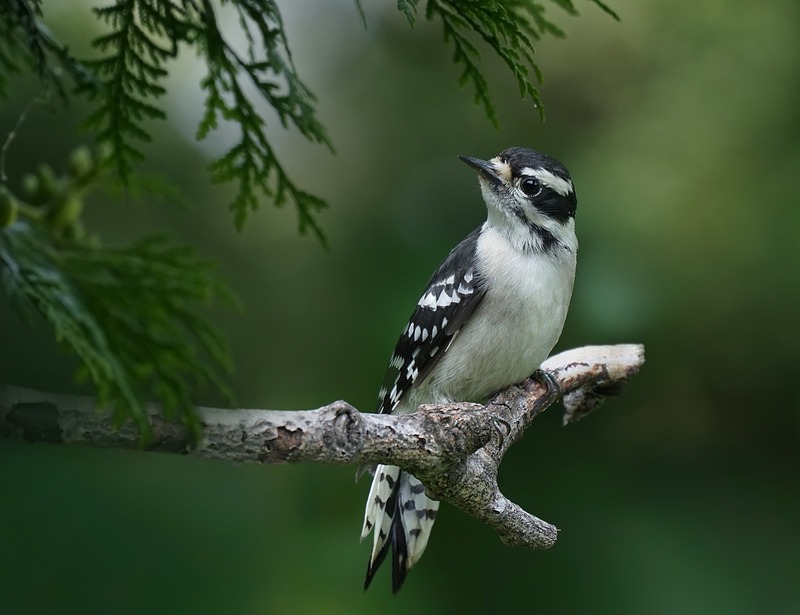
Downy Woodpecker
When it comes to identifying the Downy Woodpecker, one of the first things to notice is their size. The Downy Woodpecker is typically the smallest out of these species since it can be as small as 5.5 inches, and even its biggest height, 6.7 inches, is still fairly small compared to the other species.
Their weight and wingspan are equally as minimal compared to the other woodpeckers in Ohio with the average weight being between 0.7 to 1.0 ounces and the wingspan being between 9.8 and 11.8 inches long.
Beyond that, the colors for the woodpeckers of the northeastern regions of the US, those you will most likely see in Ohio, are predominantly white on their bellies, necks, backs (excluding the wings), and on their faces. Their faces have black streaks that go down to their wings which are also black, but they have white spots or streaks through them. The males, however, also have a very small spot of red on the back of their heads parallel to their beaks.
The typical lifespan of a Downy Woodpecker is usually two, making them one of the more short-lived of these species, but they can live to be around five years old or more before they are considered to be old.
These birds typically eat a variety of insects including beetles, caterpillars, and earworms, but a good amount of their diet comes from berries, acorns, and grains. That being said, they also like common bird seed used in feeders and are known to occasionally even drink from a hummingbird feeder.
Typically, their behaviors can range from slight hopping on the ground when eating or finding food to confidently climbing up and down trees to flying with a fast wing-speed with their wings folded against their body. However, their flight is slightly different when they are courting for a mate as they will fly more slowly through the trees in a similar way to a butterfly.
Fun fact: In the winter, the Downy Woodpeckers are known to flock with other species as a way to avoid predators and have better odds of finding food.
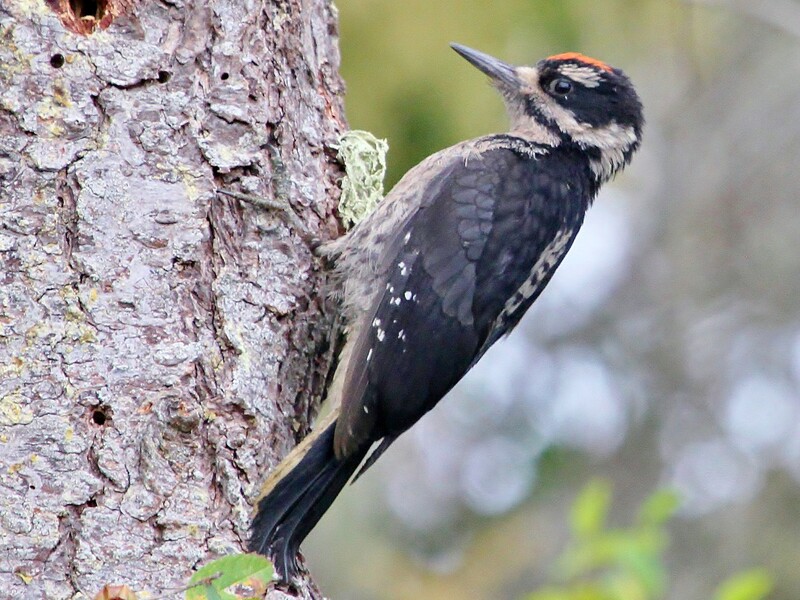
Hairy Woodpecker
The Hairy Woodpecker is about average to just under the average size in this list by being roughly 7 to 10 inches long, weighing between 1.4 to 3.4 ounces, and having a wingspan of around 13 to 16 inches.
When it comes to the color, it can be hard to distinguish this species from the previous one since they both have white bellies and backs, they have black and white stripes on their heads, and their wings are black with white spots/stripes; the males also have a red spot in the exact same spot.
However, the main way that I differentiate these two species is not by their appearance, but by their sound as Hairy Woodpeckers typically make more noise (high-pitched) while Downy Woodpeckers hardly sing if they do at all. Hairy Woodpeckers also are more commonly found in heavily forested areas or where there are large trees.
The average Hairy Woodpecker can live anywhere from 4 to 11 years old in the wild, but if they are kept in captivity, their expectancy can go well beyond 15 years.
Another way to differentiate these from the Downy Woodpeckers is that Hairy Woodpeckers typically eat insects far more than other foods like fruit and/or seeds. These insects are usually beetles, ants, and larvae, but they have also been known to eat bees/wasps, spiders, and caterpillars.
Their feeding habits also range less from eating in/around thick grass and, more commonly, they eat at the bases of trees. When they court for a mate, they also typically bob their heads, flick their wings, and point their bills high while circling a tree.
Fun fact: Hairy Woodpeckers occasionally will investigate holes that the Pileated Woodpeckers make when foraging for insects to search for food they may have missed; the sounds of the Pileated Woodpeckers draw the Hairy Woodpeckers.
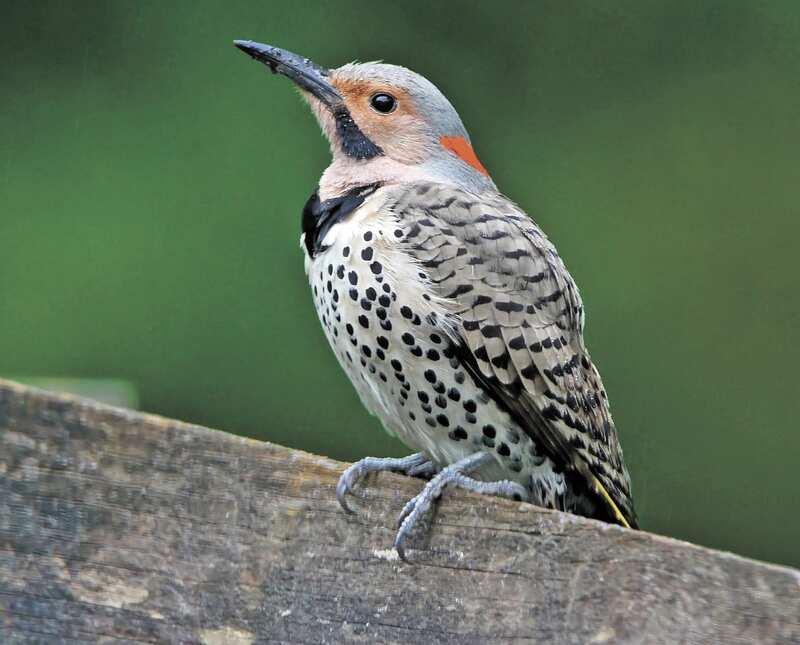
Northern Flicker
The Northern Flicker is about the average size compared to the other species as it is typically 11 to 12 inches long, 4 to 5.5 ounces, and has a wingspan of around 16.5 to 20 inches.
It is also one of the most easily identifiable species out of the others since its color and appearance are extremely unique. They have very long beaks, a brown face with a black spot that starts at the beak and stops under the eye, the top of their heads are grey (the males have a red spot), they have a large black spot on their chest (it looks like an undershirt), their bellies are tan with black spots, and their wings are dark brown with black spots.
The Northern Flicker can typically survive for several years in the wild, but the oldest (recorded) lifespan was noted to be just over 9 years old.
Their diet can vary, but much like the other species, they typically eat a variety of insects (mostly beetles and ants), fruits, and, in the winter, seeds.
It is actually fairly easy to see these birds eat among sparrows and blackbirds while they forage on the ground, but it is also easy to find them perched very stiffly on a tree branch.
When dueling for a mate, it is pretty common to see two males fighting with their bills up, bobbing their heads, and flying in a figure-8 while calling to each other.
Fun fact: The Northern Flicker tends to be more migratory than the other Woodpeckers in Ohio as they typically travel far south for the winter.

Pileated Woodpecker
The Pileated Woodpecker is one of the most popularly seen of the species given its larger size since it is about as big as a crow between its length, about 16 to 19 inches, weight, about 9 to 12 ounces, and its wingspan, about 26 to 29.5 inches.
It is also one of the more distinct species due to its colors, and this is typically what most people recognize as a woodpecker: the body and wings are black (the undersides of the wings are white), and they have black stripes on their face with the tops of their heads being red (for both males and females).
The males and females are actually very alike when it comes to their appearance, but the two easiest ways that I have found to distinguish the genders is that the males have a red cheek stripe and the red on their heads go down to meet their beaks while those areas on a female are black.
The Pileated Woodpeckers can live up to or even beyond 13 years, but they typically have a slightly lower lifespan, especially in the wild. However, they are still one of the longer-lived species of all of these birds.
The diet can vary from bird to bird as some members of this species prefer to eat more insects than seeds and fruit while others like to include a moderate balance between the two, making it one of the more unpredictable feeders out of the other Woodpeckers in Ohio.
This species is usually slower when it comes to their flight speed, and they are also one of the more monogamous and secluded, as well.
Fun fact: Mated pairs tend to remain territorial in the same area every year, but will be more open to others of their kind during the winter.
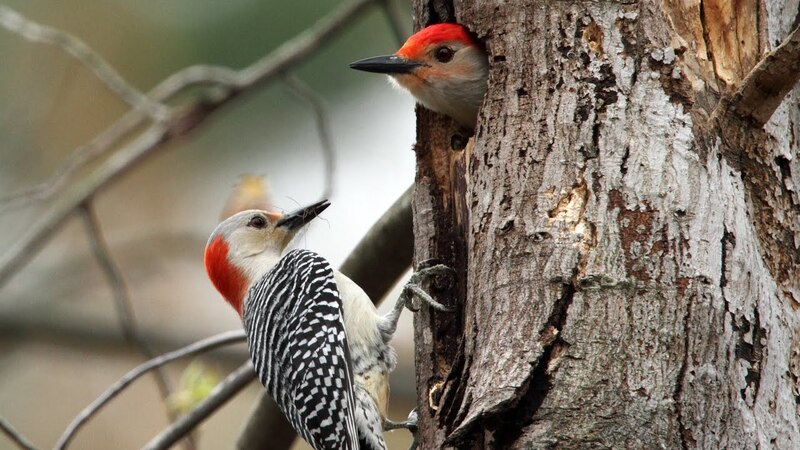
Red-bellied Woodpecker
The Red-bellied Woodpecker is about the average when it comes to its size with its length being around 9.5 inches, its weight being around 2 to 3 ounces, and its wingspan being between 13 and 16.5 inches.
Like the Pileated Woodpecker, the males and females of this species look almost identical with very few differences. Their bellies are white (or off-white), their wings are black with white tips, and their faces match their bellies. The most notable difference between the sexes is that the males have a completely red back of the neck and crown while the females have a gray crown that separates the red of their neck from the red around their beak.
Some Red-bellied Woodpeckers have lived even longer than 12 years old, but most can have a lifespan that is less than that; excluding being raised in captivity.
Like many of the other species, these birds are most commonly seen eating mostly insects, seeds, and fruits, but, not as often, they have been known to eat minnows, nestling birds, and lizards, too. They have been known to be quite aggressive to other birds when it comes to their food, as well.
The mating habits of this species are a little less flashy or aggressive compared to the others. Typically, the male prepares a nest and taps or calls from it for a female to accept it. When she does and responds with similar taps, they complete the nest together.
Fun fact: The Red-bellied Woodpeckers use a technique to store large nuts in the crevices of tree bark or a fence by bashing them in with their beaks.

Red-headed Woodpecker
The Red-headed Woodpecker species is about the same size as the previous one. Their length is, on average, 7.5 to 9 inches, their weight is around 2 to 3 ounces, and their wingspan is roughly 16.5 inches.
Because of this and their names, it is easy to assume that they might look the same, but the Red-headed Woodpecker is actually much more distinguishable due to its simplistic coloring. Their heads are completely red (a deep red), their bellies are completely white (or off-white), their backs are black, and their wings are black on the upper half and white on the bottom half.
It can be very difficult to tell the difference between the males and females since their colors can match very closely, but some note that there is a slight difference in the hue of their heads that can give it away if the pair are side by side.
In the wild, they usually live to be less than a decade old, but it is speculated that they might be able to live up to 12 years old.
The Red-headed Woodpeckers typically eat more plant-based foods than insects, usually seeds, berries, and nuts. They eat the typical insects that most other species do, but they also have been known to eat animals like small mice and even other birds, nestlings, and eggs. It is also common for them to store much of the food they find as the colder months approach, making them less likely to stay in an area where they forage for long.
An amusing behavior to watch is when they play hide and seek with their mates, usually around trees, stumps, and telephone poles, but they generally keep to themselves or are territory aggressive when the winter arrives.
Fun fact: They are very territorial to the point where they will destroy or remove other bird’s nests and/or eggs, and they will sometimes even destroy the eggs.
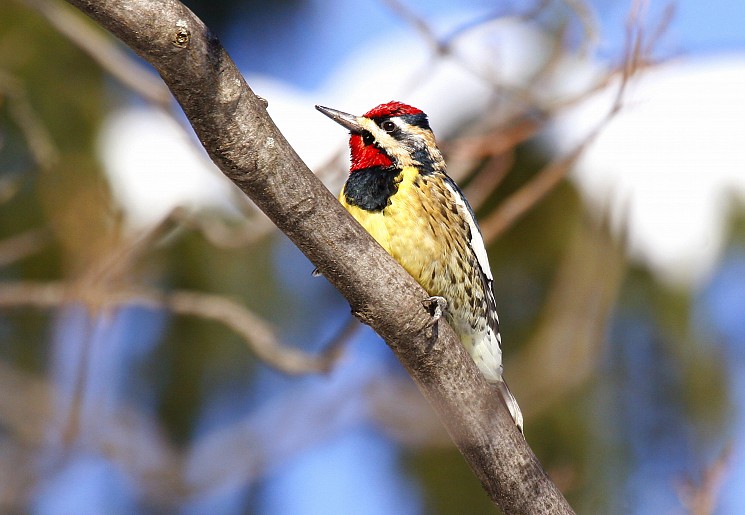
Yellow-bellied Sapsucker
This species of woodpeckers in Ohio is a little on the smaller side with its length being between around 7 to 9 inches, its weight being roughly 1.5 to 2 ounces, and its wingspan being around 13.5 to 16 inches.
The Yellow-bellied Sapsucker’s colors are quite similar to the Downy and Hairy Woodpeckers, but the body shape is more similar to the Pileated Woodpecker; it is smaller, though.
The belly is mostly white with grey near the wings, the wings and back are black with white spots/stripes, the head has white and black that join to the chest, wings, and back, and there is red from the crown to the beak. One notable difference between the males and females, however, is that the males also have red throats while the females have white throats.
Depending on the region, some males can live longer to be nearly 8 years old; although, that is the longest recorded age. In other regions, the average lifespan is thought to be around 5 or 6 years.
The diet of this species is how it got its name: its primary food source is tree sap; specifically maple tree sap. For that reason, it is fairly easy to find this species around sugar or red maples, especially around the springtime. However, they also eat insects both around the trees and ones that get stuck in the tree sap.
They court in a very playful way: chasing each other around the tree trunks and branches before landing and fluffing their feathers at each other, but despite being on the smaller and cuter side, they have been known to be very aggressive around members of the same sex.
Fun fact: The sap wells that these birds make can also attract hummingbirds, bats, and even porcupines.
Related
- Interested in birding? Check out our beginners guide and get started today.
- Want to attract more woodpeckers to your backyard? We have the solution: check out these bird feeders which woodpeckers seem to love.
Leave a Reply